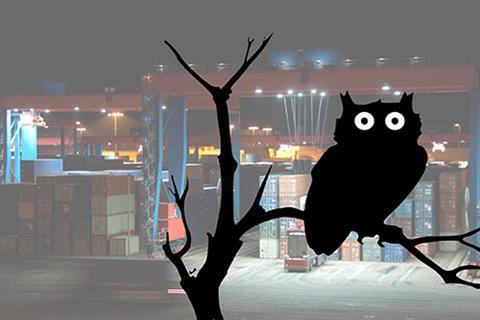After creating the image for this post, it might seem more fitting for Halloween than May. But no matter, things that keep terminal operators up at night happen all year long. Let’s identify them and offer a cure to ensure better reefer management outcomes and more frequent restful nights.

Refrigerated containers, also known as reefers, are designed to maintain specific temperatures, humidity, and airflow based on the type of cargo being shipped. However, not all refrigerated cargoes are the same. Different values may be necessary to ensure cargo quality depending on the product being shipped. For example, meats, fish, fruits, vegetables, frozen loads, pharmaceuticals, and electronics are all shipped in refrigerated containers, each requiring different settings.

The shipper sets these values when the container is loaded at the point of origin. Proper temperature and conditions must be maintained throughout the journey until the final delivery point. Every party in the cold chain handling this cargo is responsible for maintaining it, and the reefer terminal operator is always in the middle.
Terminal operators have many responsibilities from the moment a reefer arrives in their yard until it departs:
- Ensuring a safe and reliable power source is maintained.
- Managing shipper-required reefer conditions.
- Accurately collect and properly document data while the terminal handles the container.
The display module on each reefer provides a visual reference to container set points and actual internal temperatures. These values are set by the shipper to be within a specific range according to the demands of the container’s cargo. However, if these values fluctuate out of range, immediate attention is required, or the cargo may spoil, resulting in significant costs to the terminal. To maintain reefer integrity, personnel physically walk the entire yard, going from reefer to reefer, manually read the displayed data on each reefer, write down their findings (or enter them into a mobile tablet), and later transcribe or upload them to a central server.
The process of manually taking readings creates concerns for terminal operators. These are the issues that keep terminal managers awake at night:
1. Cargo losses. The value of perishable goods puts pressure on the cold chain and terminal operators to be more diligent in refrigerated container handling. Are temperature settings correct? Is the reefer connected to power? These are valid questions. The value of perishable cargo is increasing, and the cost of an error is becoming too great.
2. There are too many reefers to inspect manually. Growth is wonderful, but there comes a time when the current practices are no longer sustainable. As more reefers hit the yard, the longer it takes to inspect them, the more pressure it puts on the crew, creating higher chances for error.
3. Limited visibility into reefer status changes. Most terminals keep a schedule for manual inspections; 6-8-12 hour intervals are common. What happens if a reefer fails shortly after being inspected? It could take half a day before it is noticed – more than enough time for a container of bananas to spoil in the hot sun.
4. Mistakes can and do happen. We and our crew are only human, after all. Accuracy is only as good as the data being entered. Manually taking down data to update the system later is ripe for missteps. For instance, transposing numbers or entering °C instead of °F can have huge consequences.
5. Safety concerns remain paramount. Manual inspections require pedestrians to work near and amidst large mobile port equipment. No one wants to see someone get hurt, and port-related injuries can be devastating to families and the entire terminal community.
6. Continued growth. The first five issues were already causing nightmares, and now expansion plans are in the works. While growth is great and indicates success, it also puts more pressure on these existing concerns. Where will it all break down?
Fortunately, through automated reefer monitoring, there is a better way. In contrast to the challenges of manual inspections, automated reefer monitoring creates an environment of clarity, control, and consistency.
Here’s how remote reefer monitoring works to help terminal managers succeed:
Most reefers have an external connection point, called a data port, for accessing inherent temperature data. Monitoring devices connect to this data port and collect all the reefer’s control panel information. They automatically retrieve reefer conditions all day, every day, in any weather, and send the collected reefer data back to the terminal manager. Whenever there is a change in condition, the monitoring system signals an alert, prompting managers to quickly dispatch technicians to investigate and take necessary actions, resulting in no wasted time and protected cargo.
With Automated Reefer Monitoring, managers maintain a bird’s eye view of their entire operation, including system communications, empty reefer slots, reefers with alarms, and pending reefers. They can also observe the temperature, set points, location, and other reefer conditions at a glance. Two-way communication between the monitoring software interface and the connected reefer controller provides remote access to correct any set point discrepancies.
Reefer monitoring also has residual benefits, including access to reefer electrical usage data. By analyzing data from each reefer, a specific rack, or the entire yard, managers are better equipped to make informed decisions about implementing cost-saving measures, such as peak shaving.
The process is simple, and the results speak for themselves.
Increases on-site safety: By implementing automated reefer monitoring, technicians are no longer required to visit each reefer point to read and record data. This significantly reduces pedestrian traffic in and around the reefer yard, limiting it to critical needs and reducing the risk of injury.
Integrates data and visibility into the decision-making process: A robust reefer monitoring solution, such as RTE’s GRASP platform, will integrate all connected reefer data into the terminal’s TOS environment, providing terminal operators greater insight and control over the entire operation.
Optimizes reefer management processes: Reefer monitoring increases efficiency by enabling the more effective allocation of technicians, allowing them to react only to exceptions and giving operators greater control over daily operations.
Reduces insurance claim losses: With real-time data on temperature fluctuations and reefer mechanical failures, managers can dispatch repair technicians more quickly, reducing the chances of cargo spoilage. Additionally, a time-stamped data trail highlighting the cargo conditions while the reefer was on-site can help terminals reduce their exposure to costly loss claims.
Adds customer value and drives business growth: Sharing data builds trust. With an effective reefer monitoring solution, operators can trust the data they share. When the data on quality cargo handling is packaged and presented as a marketing tool, this can help keep existing customers happy and attract new ones to the terminal’s business.
Terminal operators have a lot to worry about when handling refrigerated containers. However, there are tools available to help. Automated reefer monitoring is a proven and effective solution for managing all aspects of their care. RTE has been innovating reefer monitoring technology since deploying the first commercially available system in 1985. Since then, we have specialized in providing systems catering to terminal operations of any size. We continue to offer unique and creative data collection and management solutions to ensure the safe transportation of perishable containerized cargo.
Contact RTE today for a complimentary review of your terminal environment and the systems best suited to meet your desired outcomes. We can also help you sleep better at night.










